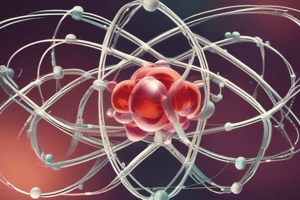Podcast
Questions and Answers
What is the main purpose of hybridization in molecules?
What is the main purpose of hybridization in molecules?
- To facilitate chemical reactions
- To mix atomic orbitals to form new hybrid orbitals (correct)
- To create molecular vibrations
- To form ionic bonds
What is the resulting shape of a molecule undergoing sp³ hybridization?
What is the resulting shape of a molecule undergoing sp³ hybridization?
- Trigonal planar
- Octahedral
- Tetrahedral (correct)
- Linear
What is a characteristic of hybrid orbitals?
What is a characteristic of hybrid orbitals?
- They are equivalent (correct)
- They are asymmetrical
- They are non-equivalent
- They are non-directional
What is the importance of hybridization in understanding molecular properties?
What is the importance of hybridization in understanding molecular properties?
What type of hybridization occurs in Ethene (C₂H₄)?
What type of hybridization occurs in Ethene (C₂H₄)?
Why is hybridization used in molecular modeling?
Why is hybridization used in molecular modeling?
What is the resulting shape of a molecule undergoing sp Hybridization?
What is the resulting shape of a molecule undergoing sp Hybridization?
What is the name of the bond formed between atoms in a molecule undergoing hybridization?
What is the name of the bond formed between atoms in a molecule undergoing hybridization?
What type of overlap forms sigma bonds?
What type of overlap forms sigma bonds?
What is a characteristic of pi bonds?
What is a characteristic of pi bonds?
Which of the following bonds is typically stronger and shorter?
Which of the following bonds is typically stronger and shorter?
What type of overlap forms pi bonds?
What type of overlap forms pi bonds?
What is a key difference between sigma and pi bonds?
What is a key difference between sigma and pi bonds?
Which of the following is an example of a sigma bond?
Which of the following is an example of a sigma bond?
Flashcards are hidden until you start studying
Study Notes
Overview of Hybridization
- Hybridization is a fundamental concept in chemistry that explains the mixing of atomic orbitals to form new hybrid orbitals.
- This process occurs in molecules where atomic orbitals of similar energy mix to form equivalent hybrid orbitals.
Types of Hybridization
- sp³ Hybridization: Mixing of one s and three p orbitals to form four equivalent hybrid orbitals, resulting in a tetrahedral shape.
- sp² Hybridization: Mixing of one s and two p orbitals to form three equivalent hybrid orbitals, resulting in a trigonal planar shape.
- sp Hybridization: Mixing of one s and one p orbital to form two equivalent hybrid orbitals, resulting in a linear shape.
Characteristics of Hybrid Orbitals
- Equivalent: Hybrid orbitals are equivalent in energy and shape.
- Directional: Hybrid orbitals are directional, meaning they have a specific orientation in space.
- Symmetrical: Hybrid orbitals are symmetrical around the central atom.
Importance of Hybridization
- Explains Molecular Shape: Hybridization helps explain the shape of molecules, which is essential for understanding molecular properties and reactions.
- Predicts Bonding: Hybridization predicts the type of bonds formed between atoms, including σ (sigma) and π (pi) bonds.
- Used in Molecular Modeling: Hybridization is used in molecular modeling to predict molecular structure and reactivity.
Common Examples of Hybridization
- Methane (CH₄): sp³ Hybridization, resulting in a tetrahedral shape.
- Ethene (C₂H₄): sp² Hybridization, resulting in a trigonal planar shape.
- Acetylene (C₂H₂): sp Hybridization, resulting in a linear shape.
Overview of Hybridization
- Hybridization is a fundamental concept in chemistry that explains the mixing of atomic orbitals to form new hybrid orbitals.
- It occurs in molecules where atomic orbitals of similar energy mix to form equivalent hybrid orbitals.
Types of Hybridization
- sp³ Hybridization involves mixing of one s and three p orbitals to form four equivalent hybrid orbitals, resulting in a tetrahedral shape.
- sp² Hybridization involves mixing of one s and two p orbitals to form three equivalent hybrid orbitals, resulting in a trigonal planar shape.
- sp Hybridization involves mixing of one s and one p orbital to form two equivalent hybrid orbitals, resulting in a linear shape.
Characteristics of Hybrid Orbitals
- Hybrid orbitals are equivalent in energy and shape.
- Hybrid orbitals are directional, meaning they have a specific orientation in space.
- Hybrid orbitals are symmetrical around the central atom.
Importance of Hybridization
- Hybridization helps explain the shape of molecules, which is essential for understanding molecular properties and reactions.
- Hybridization predicts the type of bonds formed between atoms, including σ (sigma) and π (pi) bonds.
- Hybridization is used in molecular modeling to predict molecular structure and reactivity.
Common Examples of Hybridization
- Methane (CH₄) exhibits sp³ Hybridization, resulting in a tetrahedral shape.
- Ethene (C₂H₄) exhibits sp² Hybridization, resulting in a trigonal planar shape.
- Acetylene (C₂H₂) exhibits sp Hybridization, resulting in a linear shape.
Sigma (σ) Bonds
- Formed by end-to-end overlap of atomic orbitals
- Strong and rigid bonds that occur along the internuclear axis
- Can be formed by:
- s-s overlap (e.g., H-H bond)
- s-p overlap (e.g., H-C bond)
- p-p overlap (e.g., C-C bond)
- Symmetrical around the bond axis
- Typically shorter and stronger than pi bonds
Pi (π) Bonds
- Formed by side-by-side overlap of atomic orbitals
- Weaker and more flexible than sigma bonds
- Occur above and below the internuclear axis
- Can be formed by:
- p-p overlap (e.g., C=C bond)
- Not symmetrical around the bond axis
- Typically longer and weaker than sigma bonds
Key Differences between Sigma and Pi Bonds
- Sigma bonds are strong and rigid, while pi bonds are weak and flexible
- Sigma bonds occur along the internuclear axis, while pi bonds occur above and below the axis
- Sigma bonds are symmetrical, while pi bonds are not symmetrical around the bond axis
Studying That Suits You
Use AI to generate personalized quizzes and flashcards to suit your learning preferences.




